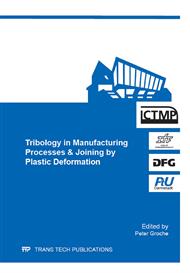[1]
Wick C., Benedict J., Veilleux R., Tool and manufacturing engineers handbook-Forming, SME, Fourth Edition.
Google Scholar
[2]
Lange K., Handbook of Metal Forming, Society of Manufacturing Engineers (SME), First Edition, U.S.A., (1975).
Google Scholar
[3]
M.S. Joun, H. G. Moon, I. S. Choi, M. C. Lee, B. Y. Jun. Effects of friction laws on metal forming processes Tribology International 42 (2009) 311–319.
DOI: 10.1016/j.triboint.2008.06.012
Google Scholar
[4]
Subramanion S., Evaluation of lubricants for stamping deep draw quality sheet metal in industrial environment. Thesis, Ohio State University, (2009).
Google Scholar
[5]
Celik G., Experimental investigation of influence parameters on forming limit diagrams of aluminum alloy-AL 2024. Thesis, Atılım University, (2010).
Google Scholar
[6]
Hatipoglu H., Polat N., Köksal A., A methodology to determine friction coefficient in Fluidcell forming process. Steel research Int 81 (2010) No: 9 (640-642), (2010).
Google Scholar
[7]
B. H. Lee, Y.T. Keum, R. H. Wagoner, Modeling of the friction caused by lubrication and surface roughness in sheet metal forming. Journal of Material Processing Techonology, 130-131 (2002) 60-63.
DOI: 10.1016/s0924-0136(02)00784-7
Google Scholar
[8]
R. Grueebler, P. Hora. Temperature dependent friction modeling for sheet metal forming. Int J Mater Form (2009) Vol. 2 Suppl 1: 251-254.
DOI: 10.1007/s12289-009-0548-z
Google Scholar
[9]
Kim H., Altan T., Yan Q., Evaluation of stamping lubricants in forming advanced high strength steels using deep drawing and ironing tests., Journal of Materials Processing Technology 209 (2009) 4122–4133.
DOI: 10.1016/j.jmatprotec.2008.10.007
Google Scholar
[10]
Wojtowicz W. J., Sliding friction test for metalworking lubricants. Lubrication Engineering, 11 (1955) 3, 174-177.
Google Scholar
[11]
ASTM International Standards, Standards for Tensile Testing, ASTM E8-04, (2004).
Google Scholar
[12]
Z. Marciniak, J. L. Duncan, S. J. Hu, Mechanics of Sheet Metal Forming, Butterworth-Heinemann (2002).
Google Scholar
[13]
E. Coruk, C. Karadoğan, Flow Curve Evaluation by Optic Strain Measurements and Force Balance at the Most Critical Section in the Neck Region of a Tensile Specimen, ICTP-2011 Aachen, Special Edition for Steel Research International, pp.714-719, Sept. (2011).
Google Scholar


